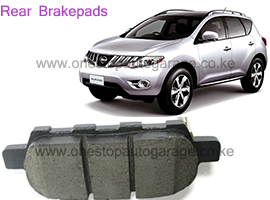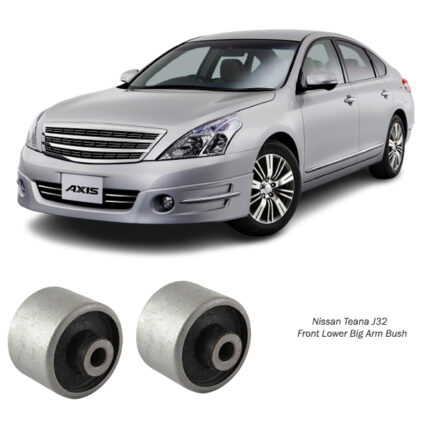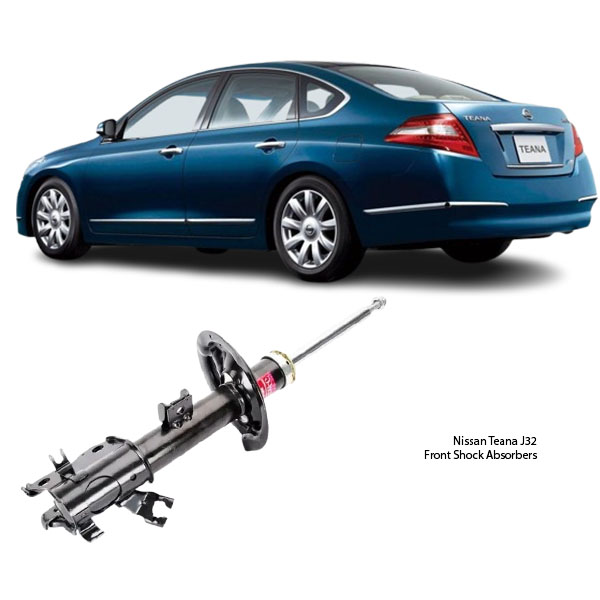Get Nissan Teana J32 Front Shock Absorbers RH / LH 339228 in Kenya
Front shock absorbers are essential components of a vehicle’s suspension system, playing a crucial role in maintaining ride comfort, handling, and vehicle stability. They absorb the impact from road irregularities, reducing vibrations and preventing excessive movement of the vehicle’s body.
Every vehicle is equipped with two front shock absorbers, one for the right-hand side (RH) and one for the left-hand side (LH). These work together to provide a smooth and controlled ride by dampening the oscillations of the suspension springs. Over time, shock absorbers wear out, leading to poor ride quality, handling issues, and increased stopping distances.
This guide explores the function, benefits, symptoms of failure, maintenance tips, and replacement process of front shock absorbers (RH/LH) in 1,000 words.
1. What Are Front Shock Absorbers?
A shock absorber (also called a damper) is a hydraulic or gas-filled component designed to control the movement of a vehicle’s suspension. It converts kinetic energy (motion) into thermal energy (heat), which is dissipated through hydraulic fluid or gas.
Each vehicle has two front shock absorbers—one on the right-hand (RH) side and one on the left-hand (LH) side—which work together to ensure even weight distribution and stability.
How Do Front Shock Absorbers Work?
- When the vehicle hits a bump or pothole, the suspension springs compress to absorb the impact.
- The shock absorber slows down and controls this motion, preventing the vehicle from bouncing excessively.
- The piston inside the shock absorber moves through hydraulic fluid or gas, dissipating energy and ensuring a smooth, stable ride.
2. Components of a Front Shock Absorber
A front shock absorber consists of several key components that work together to dampen suspension movement:
A. Piston Rod
- A metal rod that moves up and down inside the shock absorber body.
B. Cylinder
- The outer casing that holds the hydraulic fluid or gas.
C. Piston Valve
- A moving component inside the cylinder that controls fluid/gas flow.
D. Hydraulic Fluid or Gas
- Helps absorb and dissipate impact energy.
E. Mounting Bushings
- Connects the shock absorber to the vehicle’s chassis, reducing vibrations.
3. Types of Front Shock Absorbers
Different types of shock absorbers exist, each designed for specific driving conditions and vehicle types.
A. Hydraulic (Oil-Filled) Shock Absorbers
✔ Traditional type, using hydraulic fluid to absorb impacts.
✔ Provides smooth ride comfort but may wear out faster.
B. Gas-Charged Shock Absorbers
✔ Uses pressurized nitrogen gas to prevent fluid aeration (bubbles).
✔ Offers better handling and stability than hydraulic shocks.
C. Mono-Tube Shock Absorbers
✔ Has a single tube with separate fluid and gas chambers.
✔ Provides faster response and improved heat dissipation.
D. Twin-Tube Shock Absorbers
✔ Features two cylinders (inner and outer) to house fluid and gas.
✔ Common in passenger vehicles for a balance of comfort and durability.
4. Benefits of Well-Maintained Front Shock Absorbers
Properly functioning shock absorbers provide numerous benefits to vehicle safety and performance.
✔ Enhanced Ride Comfort – Absorbs shocks and reduces vibrations, providing a smoother ride.
✔ Improved Vehicle Stability – Keeps the vehicle balanced, preventing excessive leaning or swaying.
✔ Better Handling and Control – Ensures proper steering response and cornering stability.
✔ Reduced Stopping Distance – Helps tires maintain optimal road contact, improving braking performance.
✔ Prevents Tire Wear – Reduces uneven tire wear by maintaining proper wheel alignment.
✔ Minimized Suspension Damage – Prevents excessive stress on other suspension components like control arms and ball joints.
5. Signs of Worn or Failing Front Shock Absorbers
Over time, shock absorbers lose their effectiveness due to wear and fluid leaks. Here are some common signs of failure:
A. Excessive Bouncing After Hitting a Bump
- If the vehicle continues to bounce after a bump, the shocks are worn out.
B. Poor Steering Response & Handling
- If the car feels unstable or difficult to control while turning, the shocks may be failing.
C. Nose Diving When Braking
- If the front of the car dips forward excessively during braking, the front shocks may be worn out.
D. Uneven or Rapid Tire Wear
- Damaged shocks cause irregular tire contact, leading to patchy wear patterns.
E. Leaking Hydraulic Fluid
- If you notice oil stains near the shock absorbers, they may be leaking and need replacement.
F. Rattling or Clunking Noises
- Worn-out shocks can cause knocking or clunking sounds over bumps.
G. Excessive Vehicle Body Roll
- If the vehicle leans too much during cornering, it’s a sign of weak shock absorbers.
6. Maintenance Tips for Front Shock Absorbers
Regular maintenance can extend the lifespan of your shock absorbers and ensure optimal performance.
✔ Inspect Regularly – Check for fluid leaks, dents, or corrosion every 20,000 – 30,000 km.
✔ Test for Bounce – Push down on the hood of your car. If it bounces more than twice, the shocks may be worn.
✔ Replace in Pairs – Always replace both RH and LH shocks together to maintain balanced suspension.
✔ Check Mounting Bushings – Worn bushings can cause noise and instability. Replace if needed.
✔ Avoid Overloading the Vehicle – Carrying excessive weight can strain the suspension.
7. How to Replace Front Shock Absorbers (RH/LH)
Replacing front shock absorbers is a moderate-level DIY task but requires proper tools and safety precautions.
Tools Required:
🔧 Wrenches & Ratchet Set
🛠️ Jack & Jack Stands
⚙️ New Front Shock Absorbers (RH & LH)
Step-by-Step Replacement Process:
Step 1: Lift the Vehicle
- Use a jack and secure jack stands to lift the car’s front wheels off the ground.
Step 2: Remove the Wheel
- Loosen the lug nuts and take off the wheel for access to the shock absorber.
Step 3: Remove the Old Shock Absorber
- Unbolt the top and bottom mounting bolts.
- Carefully pull out the old shock absorber.
Step 4: Install the New Shock Absorber
- Align the new shock with the mounting points.
- Secure with top and bottom bolts.
Step 5: Reinstall the Wheel & Lower the Vehicle
- Put the wheel back, tighten the lug nuts, and lower the car.
Step 6: Test Drive
- Drive the car over small bumps to check for proper shock absorber function.
💡 Pro Tip: Always follow the torque specifications in your vehicle’s service manual.
Conclusion
Front shock absorbers (RH & LH) are vital for ride comfort, vehicle stability, and safety. They absorb shocks from road irregularities, ensuring smooth handling and controlled braking.
Regular inspections and timely replacements prevent excessive bouncing, poor handling, and uneven tire wear. If you experience steering instability, leaking fluid, or unusual noises, it’s time to replace the front shock absorbers.
By maintaining high-quality front shock absorbers, you ensure a comfortable, safe, and controlled driving experience for years to come. 🚗💨
Follow us on Facebook for more parts.



